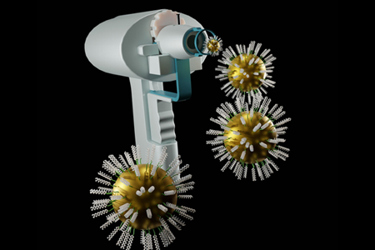Exploring Biolistic Particle Delivery Systems
By Shalini Nagar, Research Nester

Biolistic particle delivery is a technique used to introduce foreign substances, such as DNA or other molecules, into living cells or tissues. This method involves propelling particles coated with the desired substance at high velocities and directing them toward the intended cells or tissues.
The main objective of particle delivery is to insert genetic material or other molecules into cells or tissues for diverse applications, including genetic engineering, gene therapy, and plant modification. The ability to target substances into specific cells enables researchers to investigate gene functionality, alter genetic traits, or explore novel therapeutic strategies. Biolistic particle delivery systems have shown promise in gene therapy applications due to their ability to deliver genetic material directly to targeted cells. Studies have demonstrated the efficacy of biolistic particle delivery systems in treating genetic disorders such as cystic fibrosis and sickle cell anemia. However, further research is needed to fully understand the potential of biolistic particle delivery systems in gene therapy applications.
Principles Of Biolistic Particle Delivery
- Particle Coating: The genetic material, like plasmid DNA or RNA, is applied as a coating on the surface of microprojectiles. This coating enables the genetic material to be effectively transferred into the desired cells when these particles hit them.
- Acceleration: The coated microprojectiles are accelerated at high speeds using a biolistic particle delivery device called a gene gun. This acceleration is achieved by utilizing a high-pressure gas, like helium, which directs the microprojectiles toward the targeted cells.
- Penetration: The accelerated microprojectiles penetrate the cell walls or tissues of the target cells. They can do this by hitting them or by temporarily creating small openings in the cell membrane.
- Genetic Material Delivery: When the coated microprojectiles penetrate, they release the genetic material into the target cells. These cells can then take up the material and integrate it into their own DNA, which results in the expression of the introduced genes.
- Cell Recovery: Once the genetic material is delivered, the target cells are given time to recuperate. Then they are subjected to selection or screening procedures in order to identify the cells that have been successfully transformed.
Increasing Adoption in Agriculture as Well
Biolistic particle delivery has gained significant popularity in agriculture for enhancing crops. It enables the transfer of genetic material into plant cells, leading to the development of crops with improved characteristics like disease resistance, increased yield, and enhanced nutritional value. In this method, scientists utilize gene guns to shoot CRISPR tools into plant cells. These gene guns are loaded with gold particles coated with CRISPR tools such as DNA, RNA, or pre-made CRISPR enzymes.
Additionally, biolistic particle delivery systems have the potential to revolutionize sustainable farming practices by providing a targeted and efficient method of delivering genetically modified organisms (GMOs) to crops. This technology can help reduce the use of harmful pesticides and herbicides, resulting in a healthier environment and improved crop yields.
Biolistic Particle Delivery System Technologies
Biolistic delivery systems are able to deliver a wide range of molecules, including DNA, proteins, and small molecules. Lipids are used in lipofection to encapsulate the therapeutic gene and carry it to the target cells. Electroporation (Electromagnetic Systems) uses an electric field to create temporary pores in the cell membrane, which allows the therapeutic gene to enter the cell. Microparticle-mediated gene delivery (pneumatic systems) uses microparticles to deliver the therapeutic gene to the target cells. Let’s take a closer look at pneumatic systems and electromagnetic systems.
Pneumatic Systems
Pneumatics are expected to account for 61% of the global biolistic particle delivery system market by 2036. This is due to its wide application in various research fields, such as plant genetic engineering, gene transfer, and vaccination. A high-pressure air gun and automated delivery systems are among the technological advances driving pneumatics' growth. Pneumatic biolistic particle delivery systems are known for their efficiency and effectiveness, ensuring precise and accurate targeting. These systems can be used with particles of different sizes and types, making them suitable for a variety of applications. The advantage of these systems lies in their ability to provide exact control over delivery parameters, including pressure and particle velocity, which leads to consistent and reliable outcomes.
Electromagnetic Systems
Electromagnetic biolistic particle delivery systems provide a higher level of precision in delivering particles, enabling precise targeting of specific cells or tissues. This segment is expected to see significant growth over the forecast period due to increasing demand for targeted gene delivery, as well as advances in nanotechnology, which makes it more cost-effective and efficient. Additionally, the growing trend of personalized medicine is expected to have a positive impact on the segment. This system finds applications in fields such as genetic modification, drug delivery, and tissue engineering. Importantly, electromagnetic biolistic particle delivery systems minimize the harm to targeted cells or tissues, reducing the risk of cell death or damage to the tissue.
Challenges To Keep In Mind
- Biolistic particle delivery system equipment is expensive. The initial cost involved in acquiring the required equipment can pose a hindrance for many.
- Biolistic particle delivery systems can only target cells that are in close proximity to the injection site, which can limit the effectiveness of gene therapy.
- Biolistic particle delivery systems can trigger an immune response, which can limit the duration of gene expression and increase the risk of adverse effects.
- Using biolistic particle delivery systems carries a potential threat of tissue damage. The moving particles can inadvertently harm neighboring cells or tissues, which can impact the overall effectiveness and safety of the delivery procedure.
Key Players In The Field
Some key companies operating in the space are Bio-Rad Laboratories (its Helios Gene Gun was the first commercial biolistic particle delivery system), DuPont de Nemours, Thermo Fisher Scientific, E. I. du Pont de Nemours, Agilent Technologies, Biorigin BioWorks, Micromeritics Instrument Corporation, DuPont Pioneer, and Particle Sciences. These key players have played a crucial role in developing and improving the technology.
Key companies operating in agricultural uses of these systems are DuPont Pioneer and the Max Planck Institute for Plant Breeding Research.
The biolistic particle delivery systems market is expected to reach a value of $45 billion by the end of 2036, with a projected compound annual growth rate (CAGR) of 12% during the forecast period of 2024 to 2036. In 2023 the size of this industry exceeded $20 billion.
Future Developments In Biolistic Particle Delivery Systems
Biolistic particle delivery systems hold the promise of transforming gene editing methods, especially when combined with CRISPR Cas9 technology. This remarkable tool enables alterations to an organism’s DNA, creating opportunities for genetic manipulation in diverse fields like agriculture and medicine.
Biolistic particle delivery systems have the potential to enhance targeted drug delivery and therapy. By enclosing drugs or therapeutic agents in particles, we can transport them directly to cells or tissues, resulting in improved effectiveness and minimized side effects.
Recent studies have investigated the use of biolistic particle delivery systems in combination with other delivery methods, such as electroporation or viral vectors. These combinations have shown improved efficacy and reduced toxicity compared to single-method delivery.
Biolistic particle delivery systems display promise and are considered a viable alternative to other delivery methods. They offer benefits, including their ability to efficiently transform cells and deliver a wide variety of biomolecules into different types of cells. However, there is still room for improvement and innovation to enhance their performance and broaden their applications. This can be achieved through the development of new techniques or modifications to existing methods that aim to improve the efficiency of delivering particles into target cells, as well as by expanding the capability of biolistic particle delivery systems to handle larger and more complex DNA constructs. To shape the future of this market, it is essential to continue investing in research and development efforts while fostering collaborations between academia, industry, and regulatory bodies.

About The Author:
Shalini Nagar is a content associate at Research Nester Pvt. Ltd.
